A study of potential toxic effects of designed ionic liquids on bacterium Pseudomonas putida and embryos of the zebrafish (Danio rerio) as model organisms
Aleksandra Piotrowska
(Poznan University of Technology Poland, 2018)
Role of bacterial strains and bacterial communities from constructed wetlands during the biodegradation of dimethylphenol isomers.
Mónica Andrea Vásquez Piñeros
(University of Leipzig Faculty of Life Sciences, Germany 2018)
Understanding the role of a novel Magnetospirillum strain as an anaerobic toluene degrader in constructed wetland model systems through integrated omics.
Ingrid Meyer C.
(University of Leipzig Faculty of Life Sciences, Germany 2018)
Microbial toluene degradation in the rhizosphere of a constructed wetland model analysed by metaproteomics
Vanessa Lünsmann
(University of Leipzig Germany, 2017)
Microbial nitrogen transformations in constructed wetlands treating contaminated groundwater.
Oksana Coban (Brandenburg University of Technology in Cottbus, Germany 2015)
Behavior of selected organic micropollutants in horizontal subsurface-flow constructed wetlands operating at high organic load.
Otoniel Carranza Díaz (Martin-Luther-Universität Halle-Wittenberg, Germany 2015)
Treatment of groundwater contaminated with benzene, MTBE and ammonium by constructed wetlands.
Eva-Mareike Seeger (Eberhard Karls Universität Tübingen, Germany 2012)
Constructed wetland treatment of groundwater contaminated by chlorinated volatile organic compounds
Mareike Ursula Braeckevelt (PhD thesis at the University Leipzig, Faculty of Chemistry and Mineralogy, 2011
Summary PhD thesis - Mareike U. Braeckevelt (134.9 KB)
Investigations of the influence of nitrogen fertilisation on the treatment effect of a chlorinated hydrocarbon contaminated groundwater in a constructed wetland.
Anja Hahn (Diploma thesis at the International University (IHI) Zittau, Germany; 2010)
Summary diploma thesis - Anja Hahn.pdf (80.4 KB)
Treatment of waters contaminated with volatile organic compounds in constructed wetlands.
Shyam Janakiraman - from Chennai, India (Master thesis at the Technical University Hamburg-Harburg; Germany; 2009)
Summary Master thesis Shyam Janakiraman (70.4 KB)
Slow sand filtration of secondary effluent for wastewater reuse: Evaluation of performance and modeling of bacteria removal.
Kilian Langenbach (PhD thesis at the Technical University München, Germany; Lehrstuhl für Siedlungswasserwirtschaft; 2009)
Summary PhD thesis - Kilian Langenbach (159.4 KB)
Investigations on nitrogen transformation processes and stimulation of anaerobic ammonium oxidation activity in an experimental laboratory-scale wetland system.
Diego Paredes, 2009 (from Pereira, Colombia)
PhD thesis at the Martin-Luther-University Halle-Wittenberg, Centre for Engineering Sciences, Germany
summary PhD thesis - Diego Paredes (135.5 KB)
Factors of influence on the efficiency of constructed wetlands treating a contaminated groundwater loaded with volatile organic compounds and ammonium.
Paul Weißbach (Bachelor thesis at the Beuth University of Applied Sciences, Berlin, Germany; 2009)
Treatment of arsenic containing artificial wastewater in different laboratory-scale constructed wetlands.
Khaja Zillur Rahman (PhD at the Universität Stuttgart; 2009)
Summary Dissertation (80.5 KB)
On possibilities of the post-treatment of anaerobic digester effluents with high H2S loads in constructed wetlands
Alvaro Enrique Gonzalias Mosquera (PhD at the Martin-Luther-University Halle-Wittenberg; 2008)
On possibilities of the post-treatment of anaerobic digester (56.6 KB)
Constructed wetlands for the treatment of waters contaminated by chlorinated hydrocarbons - Monochlorobenzene and perchloroethene as examples (in German)
Eva Seeger; diploma thesis, University Leipzig, Germany, 2007
Diplom Thesis (ger.) (19.8 KB)
Treatment of Chlorinated Hydrocarbons Contaminated Groundwater in Constructed Wetlands – Process Characterisation in Small Scale Experimental Systems
Abstract of the diploma thesis of Zixuan Zhang from China Brandenburgische Technische Universität Cottbus, 2007
Diploma Zixuan Zhang (15.7 KB)
Investigations on the biological transformation of chlorinated benzenes in a pilot scale constructed wetland - Characterisation by means of physicochemical parameters and methods using the stable isotope 13C
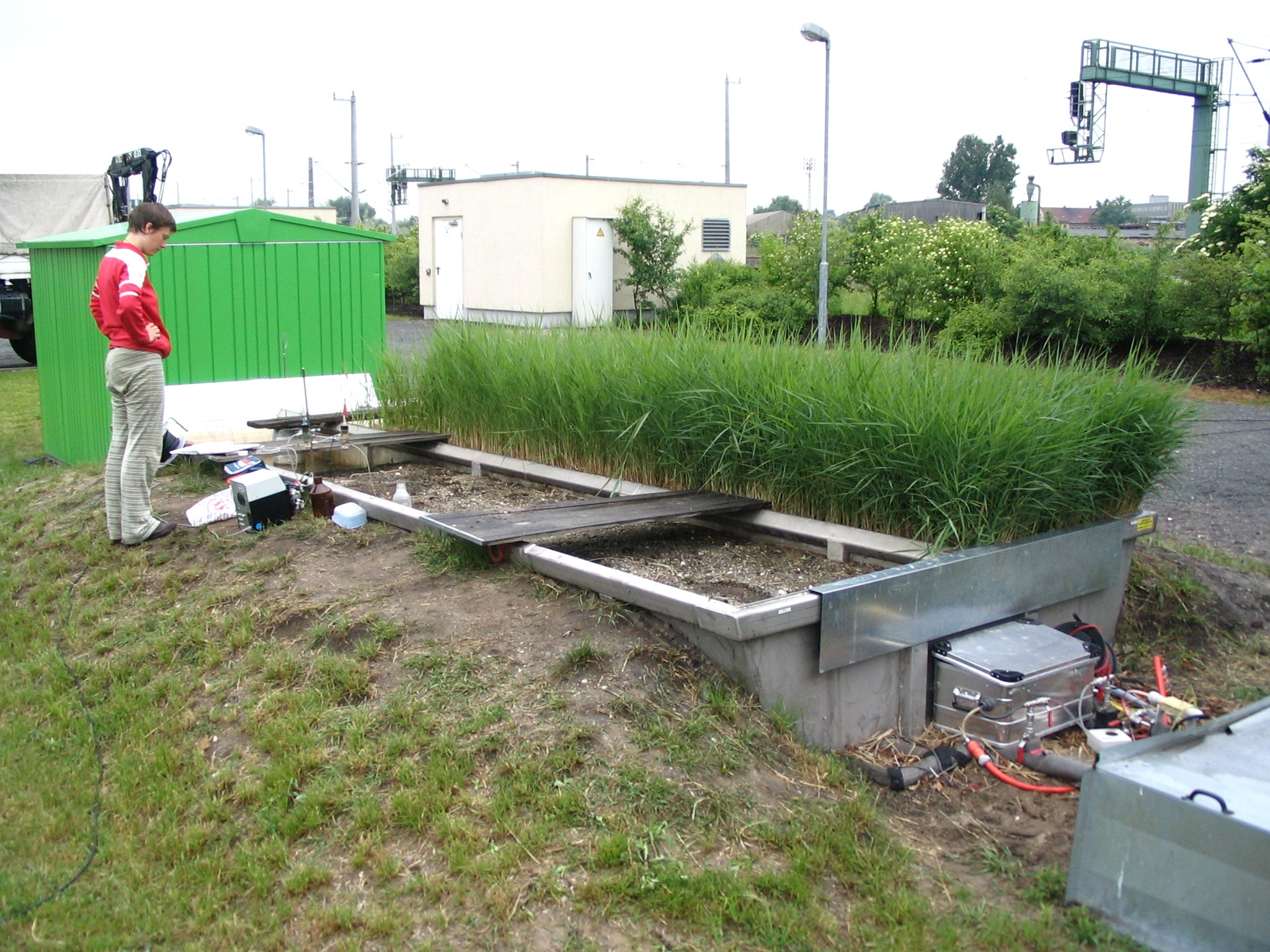
Constructed wetland for treatment of chlorobenzene contaminated groundwater in Bitterfeld/Germany
Mareike Braeckevelt (diploma work - University Leipzig, 2007)
Tolerance and reaction of helophytes to stress-influence of salt and chromate to Juncus effusus
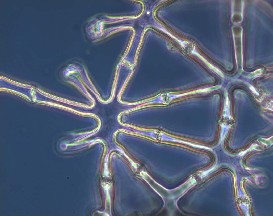
Aerenchyme tissue of Juncus effusus
Henriette Gruber (diploma work - University Jena, 2005)
Plants in constructed wetlands often have to grow under suboptimal conditions. Herbal metabolism is hampered by pollutants within the waste water. For example oxygen transport, which is essential for operation of constructed wetlands, could be interrupted.
Experiments under defined conditions should show which concentrations of salt and heavy metals do have negative effects on growth processes in plants. Changes in photosynthesis and CO2- fixation had been measured and whether there is an accumulation of toxic substances. Aim of these experiments was to set optimum ranges for the model plant Juncus effusus. Within these ranges should be guaranteed an efficient processing of constructed wetlands.
The results showed that J. effusus is completely salt intolerant. Even salt concentrations around 0.5 % are enough to affect all tested parameters negatively. For comparison: maximum capacity of salt in fresh water is 0.2 %.
In experiments with different chromate concentrations, permanent damages occur at concentrations higher than 34 µM K2Cr2O7. This concentration is conform to 10 mg chromium per litre. The WHO’s threshold for drinking water is 0.05 mg Cr/ l. However, 200 times higher concentration had no influence on J. effusus' life processes.
This is a good basis to establish J. effusus in constructed wetlands that clean chromium containing waste water.
The role of root-associated bacteria of helophytes in the degradation of xenobiotics in aquatic systems
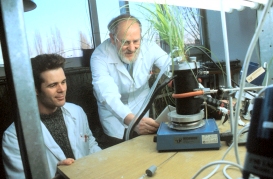
Ullrich Soltmann (left) and Helmut Wand (right)
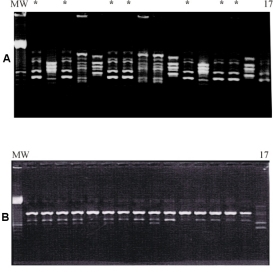
Inoculation of the rhizosphere ofCarex gracilis with Pseudomonas putida G7
Ullrich Soltmann, PhD at the University of Bremen, 2005
We are trying to establish the role played by root-associated bacteria in the degradation of xenobiotics (aromatics, phenolic compounds and PAHs) in aquatic systems using helophytes. Investigations address in particular the dependence of the composition, abundance and diversity of root-associated bacteria on the plant species, as well as the influence exerted by xenobiotics. The goal is to characterize the bacterial degraders. The methods used to characterize bacteria range from classical to molecular techniques, including DNA-fingerprinting techniques and hybridization methods with rRNA-directed gene probes. Work also involves in situ investigations of the colonization of the rhizoplane and the endorhizosphere by bacteria using laser confocal microscopy. Last but not least, the part played by plants in the degradation and elimination of xenobiotics is being studied as well. Moreover, we plan to introduce high-performance bacterial degraders into the rhizosphere to see how they compete with autochthonous bacteria and whether they are able to establish themselves in the rhizosphere.
Strain PpG7 was introduced into the naphthalene degrading sand bed planted with Carex gracilis After 2 and 10 weeks, respectively, samples were taken from roots, rhizospheric sand and root-far sand. After cultivation, fluorescent colonies, 5 each of the samples, were characterized by RAPD-PCR. Whereas after 2 weeks (A) the introduced strain – lane 17 – was detectable, indicated by stars, it was not possible to detect the strain after 10 weeks (B).
The role of root-associated micro-organisms at the nitrogen transformations in constructed wetlands
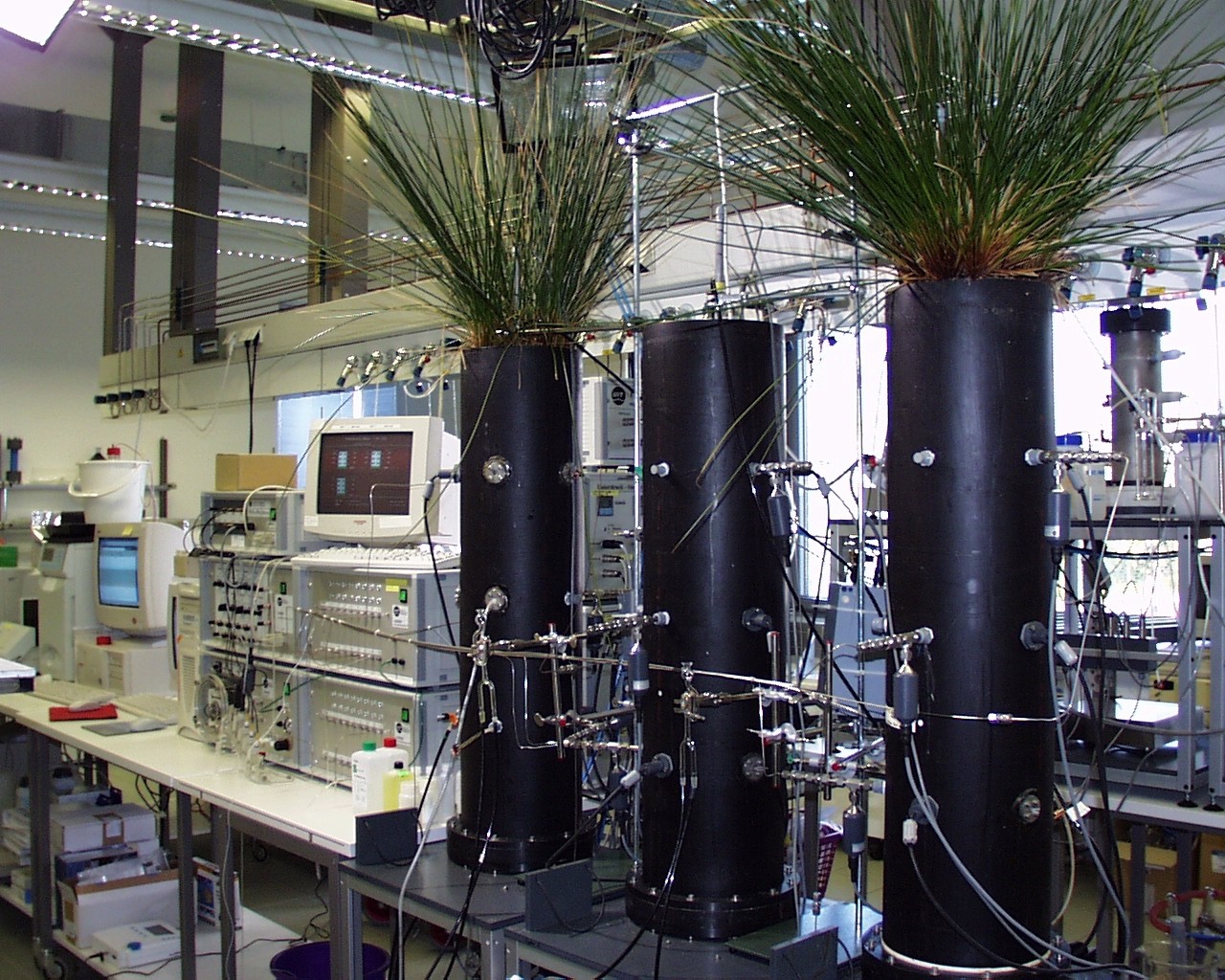
Experimental column system for characterization of nitrogen transformations
Christina Münch; PhD at the University of Dresden, 2003
Constructed wetlands and their performance for treatment of water contaminated with arsenic and heavy metals
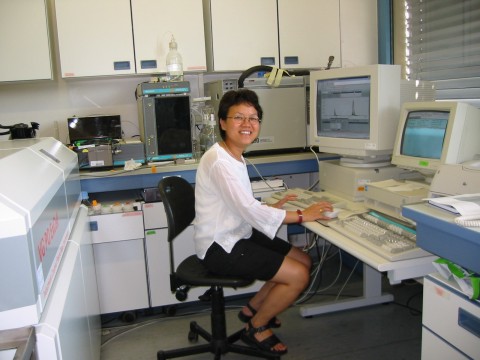
Sasidhorn Buddhawong using IC-ICP-MS coupling to separate and identify polar arsenic species
Sasidhorn Buddhawong; PhD at the University of Leipzig, 2004
The work was supported by a scholarship of the DAAD (Deutscher Akademischer Austauschdienst)
In batch models of wetland systems, the performances of As and heavy metal removal from artificial wastewater varied with the type of the constructed wetland. The subsurface wetland (SSW) and free surface wetland (FSW) removed heavy metals better than hydroponic system (HP) and algae pond (AP). The combination of gravel bed and plants (e.g. Juncus effusus) resulted in a high removal rate. The heavy metals mostly accumulated in the plant roots. The remaining amounts were bound to the gravel, precipitated, attached to or incorporated into the cells of microorganisms and adsorbed on sediment to the bottom.
Also a two step constructed wetland system with continuous flow, consisting of HP and FSW was tested for the removal of As, Zn and Cr from an artificial wastewater. A high removal rate was observed in the first phase of the experiment, when a high load of carbon source was supplied, which enhanced anaerobic conditions. Zn, As and Cr probably precipitated with iron and S2-, which were present in the systems. As(V) could precipitate as FeAsO4 or be immobilized on hydrated iron oxides. Under anaerobic conditions, As(V) was reduced to As(III), which could precipitate with S2-. The average removal efficiencies of the HP decreased in the sequence Cr ≈ Zn > As (118, 114 and 18 mg/m2d, respectively).
The results showed that J. effusus is completely salt intolerant. Even salt concentrations around 0.5 % are enough to affect all tested parameters negatively. For comparison: maximum capacity of salt in fresh water is 0.2 %. As the toxicity and the environmental behaviour of As strongly depends on the species in which it is present; also the As speciation was investigated in the experiments described above. The data show that methylated arsenic species occurred under reducing conditions. In particular, As(III) was found in compartments with low concentration of oxygen, i.e. near the bottom of the SSW and FSW wetlands, and in the HP of the two-step constructed wetland. Methylated arsenic was also found in the AP due to the appearance of algae which could transform toxic As(V) to other non-toxic As species.
The planted FSW in a field test was highly effective for treatment of acidity and metals from acid mine drainage, with a removal capacity for acidity of about 34-51 mmol NaOH/m2d, for Zn of about 4-10 mg/m2d and for Fe of about 73-122 mg/m2d. SSW and HP also remove acidity and metals, although to a lower extent. The hydroponic systems had significantly less capacity for the removal of all parameters than the systems containing soil material.
The plants in the system promoted the neutralization and took up metals from wastewater. In both FSW and SSW, Zn and Fe were accumulated in the roots and at the root surface rather than in the shoots. Soil materials were found to accumulate Fe rather than Zn, especially in the planted FSW.
In conclusion, constructed wetland systems with a combination of gravel/soil matrix and plants have a high removal rate of heavy metals in both lab models and a field test system.
Abstract Sasidhorn Buddawong (66.5 KB)Conditioning and long-term remediation of sludge residues and contaminated soils (coal chemistry and petrochemistry) by macrophytes
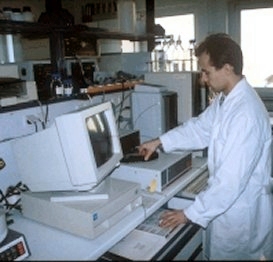
Thorsten Hübner at the HPLC-system
Thorsten Hübner, PhD at the Universität Halle, 2002
Investigations study the effect of plants growing on contaminated sites (especially those polluted by PAHs, phenols and hydrocarbons) on decontamination, toxicity and soil texture. Of special interest are also the stimulation of microbial activity in the soil by plants, rooting behaviour in relation to zonal contaminant distribution, and transpiration rates. Initial investigations will take the form of lab-scale experiments in the greenhouse.
Hueber Thesis (78.7 KB)Impact of rhizodeposition on microbial degradation of xenobiotics
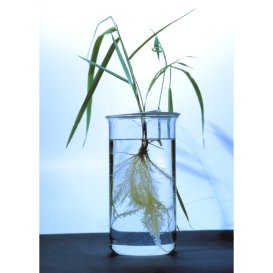
Visible slime layer on the roots of Phalaris arundinaceae exposed to phenol
Horst Moormann, PhD at the University of Bremen, 2001
he role of roots as a habitat for micro-organisms exposed to pollution and their possible impact on pollutant degradation is currently being investigated. Research is also being carried out into the effect of rhizodeposition and plant debris on the degradation of xenobiotics in an effort to explain whether these substances act as growth substrates for microorganisms and how microorganisms can be encouraged or enabled to degrade persistent organic pollutants. Investigations are being performed on hydroponic cultures with various xenobiotics such as phenol, chlorophenols etc.
Thesis "Einfluss der Rhizodeposition von Helophyten auf den mikrobiellen Schadstoffabbau" aloe_magdeb_seminar_Hirt.ppt (2.9 MB)
Phytovolatilization - the emission of volatile organic xenobiotics by helophytes exposed to industrial effluents
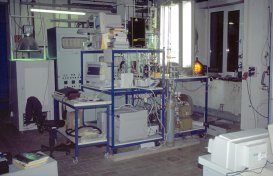
Lab research system for estimating phytovolatilization
Oliver Baeder-Bederski PhD at the University of Leipzig, 2000
Remediation with systems based on green plants and their associated microorganisms (phytoremediation) can be used as an inexpensive method of treatment for contaminated sludges and industrial wastewaters. One function of the plants is to eliminate volatile pollutants by increasing the volatilization rate. However, the potential transfer of volatiles in this biological (open) system must be understood if the uncontrolled transfer of toxic products into the air is to be prevented. In order to examine the effect of plants on volatilization, the plants are placed in a gas exchange chamber combined with a hydroculture vessel. To reduce abiotic emissions, the waterlogged gravel is sealed with wax. For qualitative investigations, a laminar stream of catalytic purified air or doted air flows downstream through the gas-tight chamber. For the test system we are using Iris pseudacorus. Our investigations focus on volatilization from the plant and absorption into the leaves. In experiments with 2,6-dimethylphenol contaminated water (30 ppm), we have detected 2,6-dimethylphenol near the leaf surface after 10–15 h of root exposure.
Thesis Summary: Phytovolatilization – the emission of volatile organic xenobiotics by helophytes exposed to industrial effluents Abstract Phytovolatil. (20 KB)
